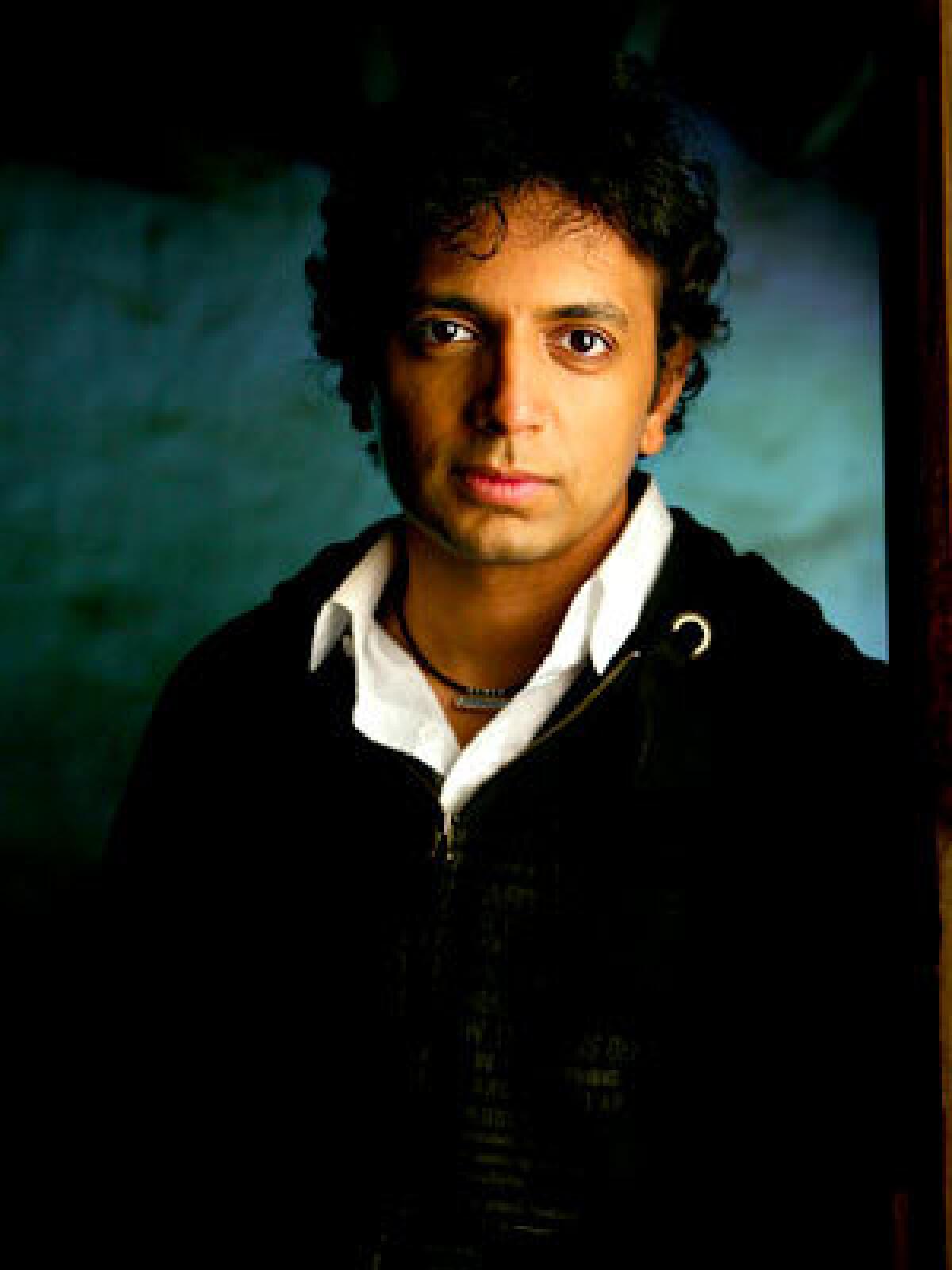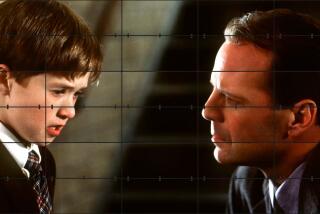A sadder but wiser M. Night Shyamalan

MALVERN, PA. — HE DESCRIBES the experience of making “Lady in the Water,” the biggest flop of his career, as something akin to stripping off all his clothes and running outside to have the world collectively laugh at him.
But in a good way.
M. Night Shyamalan, the 37-year-old film director who shot to fame with “The Sixth Sense” in 1999, is not talking about large-scale humiliation but rather personal empowerment -- the freedom that comes from giving up concern about other people’s expectations.
“My hope for the movie was a personal one,” he says. “I’m sick of feeling like I hope the cool people like me. I hope the teachers like me. You know that thing you do when you’re in school? And you’re in your mid-30s and you go, ‘I’m sick of feeling this way.’ And you kind of like have this urge to take all your clothes off and run outside and say, ‘Make fun of me. Are we done? Is that it? Good, let’s go on with our lives.’
“That really is what happened and I feel like I’ve been cleansed in some way.”
Just weeks before the opening of Shyamalan’s new movie, “The Happening,” a phantasmagoriaof paranoia that arrives on Friday, the director is sitting in the private dining room of Creighton Farm, his little equivalent of Skywalker Ranch. His business offices and editing suite are set in a colonial stone home on this bucolic spread of Pennsylvania land. Across the walls, in chronological order, are the posters from his movies, from the little-seen early ones -- “Praying With Anger” and “Wide Awake” -- to the better-known -- “The Sixth Sense,” “Signs” and “The Village.”
Everything about Shyamalan the person appears pristine, precise, aesthetic. He’s extremely thin, in a white shirt and jeans. A private chef -- who cooks for everyone who works at Creighton -- has served an immaculate lunch (Thai chicken, wasabi mashed potatoes) in tiny portions, each the size of a baby’s fist. Yet the director also exudes a disconcerting mixture of warmth, guilelessness and confidence -- though not the walk-on-water sunny assurance he had in conversation four years ago. A vague soupçon of chagrin hangs over him. He’s been through a complete cycle of media glorification and diminution, and emerged chastened but certainly not bowed. He’s also, perhaps more important, not embittered.
Shyamalan occupies an unusual place in the pop-culture pantheon. He’s a writer-director, an auteur of popcorn films, who has turned his own idiosyncratic brew of horror, psychology and spirituality into a global brand. Most of the directors who’ve come of age with him have divided themselves into two camps: the entertainers and the artistes. The entertainers -- Gore Verbinski, Sam Raimi, Doug Liman, Christopher Nolan, Bryan Singer -- have almost all gravitated to big franchise fare, the juggernauts that Hollywood prizes most, such properties as “Spider-Man,” “Batman” and “X-Men.” The artistes, most of whom write, include Wes Anderson, Paul Thomas Anderson, David O. Russell and Quentin Tarantino. Most have made occasional missteps into insular self-importance and almost none has reached as broad an audience (nor made as much money) as Shyamalan.
The downside is steep
UNTIL NOW, Shyamalan has gotten a lot of approbation -- and flak -- for having a foot in both camps. He’s received two Oscar nominations, but when he misfires, the fan base goes ballistic rather than simply wrinkle its nose in disappointment, as might happen for another director. And, oh yes, like Alfred Hitchcock, Shyamalan puts himself in small roles in most of his movies -- though his acting is less inspired than his filmmaking.
If Shyamalan had been just another writer-director trying to tell original stories, “Lady in the Water,” released in 2006, would be considered just another arty misstep on the tortuous path of originality. But the film, a fractured fairy tale about a water nymph sent to awaken a mortal to make the world a better place, engendered outright vitriol. As Manohla Dargis wrote in the New York Times, it was unclear what the nymph was trying to get the humans to hear, “the crash of waves, the songs of the sirens, the voice of God -- until we realize that, of course, we’re meant to cup our ear to an even higher power: Mr. Shyamalan.”
The director’s distress was amplified by the fact that he’d cooperated with a tell-all book by Sports Illustrated writer Michael Bamberger, “The Man Who Heard Voices: Or, How M. Night Shyamalan Risked His Career on a Fairy Tale and Lost.” The words “and Lost” were added to the paperback edition after the film failed commercially. Although the book is fairly sycophantic, Shyamalan is portrayed as veering between arrogance and self-doubt with a huge chunk of mono-obsession thrown in, not unlike so many other directors.
In truth, he comes off infinitely more humane than most of the directors that appear in, say, Peter Biskind’s histories of Hollywood, “Easy Riders, Raging Bulls” and “Down and Dirty Pictures.” But one incident recounted in “The Man Who Heard Voices” became notorious -- playing out in newspapers and magazines across the country. That’s when Shyamalan broke off with his longtime corporate benefactor, the Walt Disney Co., after executives expressed concerns about “Lady in the Water.”
Not only was it unusual to have an actual airing of creative differences, but the moral of the story ran counter to the myth of the filmmaker as the guy who teaches the bean-counters about risk and ingenuity. In this case, the suits turned out to be right. The film was flawed. Schadenfreude careened around the studios like the metal ball in a pinball machine.
Now, in retrospect, Shyamalan cops to a certain amount of innocence in letting his personality all hang out. “He didn’t misquote me or anything like that. We both were naive in terms of thinking that being open is the best way. Don’t play the game.”
The media contretemps was stressful and upsetting, but he tries to be stoic about the vicissitudes of Hollywood fame. “The love-hate relationship that goes to love for a while and goes to hate for a while and then goes back to love. . . . You can let yourself get snapped and break in that process,” he says. “I’ve watched so many friends going through it. People I admire have gone through it, you know, on much worse scales. The only answer I’ve thought of in terms of how to handle the [fallout] is be truthful of myself and consistent as long as they let me make movies.”
And he has one more mantra: “Don’t ever fall to the temptation of ‘I’m going to chase you as my audience,’ ” he says, noting, “As soon as you do that, the system broke you.”
Chalk it up to inspiration
ONE COULD think of “The Happening” as a calculated rebound from “Lady in the Water,” a genre-movie chaser as a safe follow-up to a risky film that flopped. (Indeed, Shyamalan will soon have his own franchise -- he’s about to embark on an ambitious three-picture cinematic rendition of the Nickelodeon cartoon “Avatar: The Last Airbender.”)
Yet, Shyamalan insists he doesn’t operate that way. In fact, he wrote “The Happening” before “Lady in the Water” was even finished.
He was driving to New York City, which is a couple of hours from where he lives in Pennsylvania. “You get into a kind of hazy half-sleep. And this idea kind of bloomed and it was big. The plot, like you could feel it. Sometimes the thing that makes me make a movie is a character. Sometimes it’s a scene. And sometimes it’s a structure. And this one had a structure to it which is really, again, another really wonderful moment if it happens.”
The image in his head was a lot like the one that is on the poster, a forbidding road with abandoned cars and people mysteriously absent. “It’s 90 minutes of just straight paranoia,” Shyamalan says, like Hitchcock’s “The Birds,” in which birds inexplicably begin attacking human beings.
It’s one of those movies where the less you know, the scarier it is, and “The Happening” begins with a bang: People stop frozen in New York City’s Central Park and then begin inexplicably killing themselves with a kind of stunned matter-of-factness. Is it an airborne toxin? Global warming gone vicious? The mass psychosis spreads like a virus through the Northeast, sowing numbed panic as humans scamper to outrun the threat.
It’s Shyamalan’s first R-rated film and it was the studio, 20th Century Fox, that encouraged him not to stint on the violence and blood. “Night has an uncanny gift at exploring the recesses of the human psyche,” says outgoing studio Vice Chairman Hutch Parker, and in this film, particularly, “the psychology of fear. We felt that the R rating would allow Night to go beyond the limits he explored so far, breaking new ground for himself and for the audience.”
Yet, the terror is wrapped up in a reconciliation drama between a young couple played by Mark Wahlberg and Zooey Deschanel. “It’s a normal day in their kind-of-troubled marriage,” Shyamalan says. “And then this thing happens on this day. And if you got to the point where you knew in the next minute you were going to be dead. You both know it; you’re not fighting it anymore, it’s a fait accompli. You get one last conversation. What do you say to each other? That’s what the movie ultimately is about.”
Shyamalan famously identifies himself as a family man. He met his wife, Bhavna, while he was still at NYU, and during their first year of marriage they lived in his parents’ house. Now they have two daughters. What would he say to his wife if they had only a few minutes to live? Shyamalan has to pause a moment.
“The good thing for me is that my wife, she genuinely makes me a better person,” he says finally. “She’s not just a light, surface person. You will never have a conversation about what someone looks like or anything. It’s just not the conversations that we have. They’re always the conversation that you have at the end. I think the strength of the relationship is that we always are aware. That’s why it’s not so unusual for me to think about if it all went away. Because you’re always thinking about that, you know?”
However, at the last moment, he says he would not try to be too profound. That’s the Shyamalan twist to this particular story.
“I probably would have a real casual conversation,” he says. “One last laugh. One moment about the irony of life . . . that what we thought was so important was so, so not important.”
More to Read
The biggest entertainment stories
Get our big stories about Hollywood, film, television, music, arts, culture and more right in your inbox as soon as they publish.
You may occasionally receive promotional content from the Los Angeles Times.










